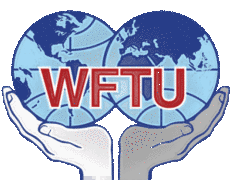TAFTA/TTIP the foremost point to capital International Trade Union Symposium WFTU- CTB San Paulo 1-3 October 2015 USB - Italy
The European Union and the United States are currently negotiating the Trans-Atlantic Trade and Investment Partnership (TTIP), a major trade agreement intended to further integrate their economies. In today’s low-tariff reality, TTIP focuses on removing non- tariff trade barriers between countries, such as differing standards set in the EU and in the US for given consumer goods and services. The underlying logic is the same as in traditional liberalizations: reducing the costs of trade – whether eliminating tariffs or other impediments – is supposed to lead to a higher trade volume and overall economic benefits,
Negotiations are carried out by experts, representatives of industries and the ETUC who have access to confidential documents.
The goal is to build the largest free trade area in the world and open both markets to common goods and public services, that large multinational companies aspire to manage criteria merchant
3
EUROPE 28
4
Some call it the Transatlantic Free Trade Area (TAFTA) and others call it the Transatlantic Trade and Investment Partnership (TTIP). They’re both names for the same thing, a dangerous proposal.
5 timing
The dialogue between the biggest multinational companies of Europe and USA, in the form of behind-the-scenes consultations, aiming at lifting the rules that are obstructing their expansion on both sides of the Atlantic, began in 1995.
European union and united states launched discussion on TTIP on July 2003.
In February 2013 Barak Obama announced officially the beginning of negotiations. In July of the same year started the first round and TAFTA (Trans-Atlantic Free Trade Agreement) was renamed TTIP (Transatlantic trade and Investment Partnership.
The negotiations, conducted in absolute non-transparency and covered by a veil of mystery given that bodies such the US congress and the european parliament do not have access to document relating to the agreement,
negotiations were to be completed by December 2014. But there are deep differences on financial services that the US wants to leave out in the Treaty.
70% in US investment in Europe are financial services.
They should be concluded by the end of 2015
6
TTIP is being hailed as one of the largest trade agreements in history . What kinds of number are we talking about?
• World's largest trade market
– 50% of world GDP and 30% of world trade
– – €1.8 billion/day and €723 billion/year of goods and services traded
– • 15 million transatlantic jobs
– • €2,4 trillion of mutual investment stocks
7
What exactly would TTIP do?
• eliminate all trade tariffs and reduce non-tariff barriers
• Tariffs between the U.S. and EU are already lower than an average of 4 percent
• Non-tariff barriers is a main focus of the negotiations
•Want to expand market access for trade in services
• Industries got benefit from non-tariff barriers to market access.
8
Objectives
The main goal of TTIP is to remove regulatory ‘barriers’:
• labor rights,
• food safety rules,
• the use of toxic chemicals,
• digital privacy laws
• new banking safeguards(to prevent a repeat of 2008 financial crisis)
9
Significance of TTIP Market integration, harmonization of standard. What they say:
• Estimated gains for the EU (€120 billion) and the US (€95 billion),once fully implemented.
• EU exports to the US would go up by 28%, (€187 billion worth of exports of EU goods and services). EU imports from the US would increase by €159 billion.
• Estimated millions of Euros of savings, hundreds of thousands of jobs created.
• Higher national income.
• Boost trade by creating increased demand and supply without having to increase public spending or borrowing.
•Decrease value added in production.
•More difficult to access to EU-US market with mandatory standards and rules of origin.
•Developing-country firms are hurt more by an increase in the stringency of standards and benefit less from economies of scale in integrated markets.
10.
Raise one issue:
- The U.S. is seen as having stronger rules in financial services, thus there may be more regulation to lose than gain in trade talks, while Europe touts its rules as superior in food safety and other sectors.
• The EU is putting more pressure on the US to include financial regulation on the talks.
• However, the US does not want to make any concessions. They refuses to reopen, weaken, or undermine implementation of the Dodd-Frank Act, which was introduced to tighten bank regulations after the 2008 crisis.
11
• The use of growth promoters in food production has been a highly contentious issue between the EU and U.S
• In the U.S, protein and β-agonists are given to animals and some antibiotics put into water and feed to increase growth and feed efficiency.
• In the EU, against the law and against the Code of Ethics for veterinarians, to give animals drugs for non-therapeutic purposes.
12
Europe/USA imperialist poles
the largest world market is Europe
why join the largest world market and North American markets?
to create the largest free trade area in the world, which accounts for half of global GDP (Gross Domestic Product) and a third of the global market.
the need is to create a common front to mark the rise of the BRICS (Brazil Russia India China and South Africa)
china is the opponent they want to stop
in 2020, China would overtake the United States to the produced annual wealth
13
Favorable conditions in this agreement are determined by economic stagnation which is seeking European markets, even if EU will have reduce its quality and production standards.
Infact the center of the agreement lies in the removal of non-tariff barriers (tariffs are low 3-4%).
those technical limitations such as quotas, subsidies to firms, the legislation on technical standards of environmental safety and health.
EU main source of foreign profits for USA
230 billions in 2013 – 57 % of total
European Union (GDP) in 2012: around 13.000 billion euros
EU commercial exchange with other countries represents 20% world trade exportation
EU is the largest trading bloc in the world:
16,4 % import – 15,5 export
14
TTIP provides also:
intellectual property agreements
ISDS Investor-State Dispute Settlement
investors can make lawsuits against States for ‘loss of profits’
This allows investors to bring lawsuits against States for loss of profits and a way to bond even more states in the field of economic and social policy.
with the threat of a lawsuit if a State measure is to harm the interests of big corporations
for example the support of an economic sector
nationalization
a minimum wage law
15
Many studies demonstrate that TTIP gets a lot of criticism from different points
TTIP would lead to losses in terms of net exports after a decade, compared to the baseline “no-TTIP” scenario. Northern European Economies would suffer the largest losses (2.07% of GDP) followed by France (1.9%), Germany (1.14%) and United Kingdom (0.95%).
TTIP would lead to net losses in terms of GDP. Consistently with figures for net exports, Northern European Economies would suffer the largest GDP reduction (-0.50%) followed by France (-0.48%) and Germany (-0.29%).
TTIP would lead to a loss of labor income. France would be the worst hit with a loss of 5,500 Euros per worker, followed by Northern European Countries (-4,800 Euros per worker), United Kingdom (-4,200 Euros per worker) and Germany (-3,400 Euros per worker).
16
TTIP would lead to job losses. they calculate that approximately 600,000 jobs would be lost in the EU. Northern European countries would be the most affected (-223,000 jobs), followed by Germany (-134,000 jobs), France (- 130,000 jobs) and Southern European countries (- 90,000).
TTIP would lead to a reduction of the labor share of GDP reinforcing a trend that has contribute to the current stagnation. The flipside of this decrease is an increase in the share of profits and rents in total income, indicating that proportionally there would be a transfer of income from labor to capital. The largest transfers will take place in UK (7% of GDP transferred from labor to profit income), France (8%), Germany and Northern Europe (4%).
17
TTIP would lead to a loss of government revenue. The surplus of indirect taxes (such as sales taxes or value-added taxes) over subsidies will decrease in all EU countries, with France suffering the largest loss (0.64% of GDP). Government deficits would also increase as a percentage of GDP in every EU country, pushing public finances closer or beyond the Maastricht limits.
TTIP would lead to higher financial instability and accumulation of imbalances. With export revenues, wage shares and government revenues decreasing, demand would have to be sustained by profits and investment. But with flagging consumption growth, profits cannot be expected to come from growing sales. A more realistic assumption is that profits and investment (mostly in financial assets) will be sustained by growing asset prices. The potential for macroeconomic instability of this growth strategy is well known
18
a part of the European Parliament expressed its opposition to a harmonization of regulations with those of the United States because the risks are high and the process irreversible
one million and 700,000 Europeans have signed the petition asking the European Commission for the immediate arrest of the negotiations on TTIP
a petition that is growing consensus
criticism came from many quarters
19
The process of concentration and centralization of capital will lead:
• A strengthening of the multinationals
Democracy becomes more functional to profit
The main impact in the field of social rights and labor
failure to respect the fundamental rights of workers
the rights of collective representation
Creation of new markets by opening up public services with the danger of new wave of privatizations in key sectors such as health, education and water
Easing of rules and technical standards, like the precautionary principle that we have in Europe
Deregulation on use of GMO in agriculture
Spread of extraction technique for shale-gas (fracking) – this procedure is lethal for phreatic freshwater lens
Restriction of freedom of movement of persons
The absence of penalties for abuses in the right social, labor, environmental, climate protection, the gradual disappearance of public services, rising unemployment, more importance of intellectual properties of multinationals than people health and safety
20
The response of working people, but also of all the progressive forces, must be the mobilization of working people, the strengthening of the struggles and enhancing of the coordination of actions against the policies of the multinational companies for the defense of labor and social gains
22
Ref.
http://europa.eu/about-eu/facts-figures/economy/index_it.htm
W. Jacklein, Dieci minacce per il popolo americano e dieci minacce per il popolo europeo, Le monde diplomatique ed. it. Giugno, 2014
J. Capaldo, The Trans-Atlantic Trade and Investment Partnership:European disintegration, Unemployment and Instability
Luciano Vasapollo, L’Alba di una futura umanità, Natura Avventura edizioni, 2015





